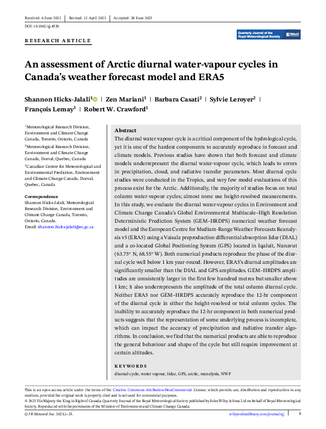Title
An assessment of Arctic diurnal water-vapour cycles in Canada's weather forecast model and ERA5
Authors
Hicks-Jalali, S., Mariani, Z., Casati, B., Leroyer, S., Lemay, F. and Crawford, R.W.
Published
by Royal Meteorological Society (RMetS) at 2023-07-08
Abstract
The diurnal water-vapour cycle is a critical component of the hydrological cycle, yet it is one of the hardest components to accurately reproduce in forecast and climate models. Previous studies have shown that both forecast and climate models underrepresent the diurnal water-vapour cycle, which leads to errors in precipitation, cloud, and radiative transfer parameters. Most diurnal cycle studies were conducted in the Tropics, and very few model evaluations of this process exist for the Arctic. Additionally, the majority of studies focus on total column water-vapour cycles; almost none use height-resolved measurements. In this study, we evaluate the diurnal water-vapour cycles in Environment and Climate Change Canada's Global Environmental Multiscale–High Resolution Deterministic Prediction System (GEM–HRDPS) numerical weather forecast model and the European Centre for Medium-Range Weather Forecasts Reanalysis v5 (ERA5) using a Vaisala preproduction differential absorption lidar (DIAL) and a co-located Global Positioning System (GPS) located in Iqaluit, Nunavut (63.75° N, 68.55° W). Both numerical products reproduce the phase of the diurnal cycle well below 1 km year-round. However, ERA5's diurnal amplitudes are significantly smaller than the DIAL and GPS amplitudes. GEM–HRDPS amplitudes are consistently larger in the first few hundred metres but smaller above 1 km; it also underrepresents the amplitude of the total column diurnal cycle. Neither ERA5 nor GEM–HRDPS accurately reproduce the 12-hr component of the diurnal cycle in either the height-resolved or total column cycles. The inability to accurately reproduce the 12-hr component in both numerical products suggests that the representation of some underlying process is incomplete, which can impact the accuracy of precipitation and radiative transfer algorithms. In conclusion, we find that the numerical products are able to reproduce the general behaviour and shape of the cycle but still require improvement at certain altitudes.
Citation
Hicks-Jalali, S., Mariani, Z., Casati, B., Leroyer, S., Lemay, F. & Crawford, R.W.(2023) An assessment of Arctic diurnal water-vapour cycles in Canada's weather forecast model and ERA5. Quarterly Journal of the Royal Meteorological Society, 149(755, 2550–2574. https://doi.org/10.1002/qj.4520
